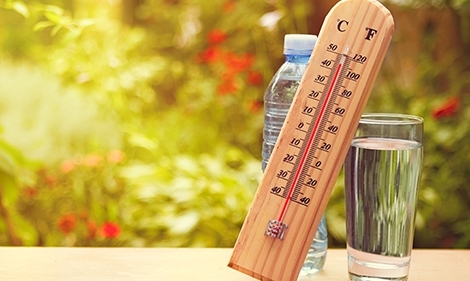Heat Illness - Education and Prevention Reduce the Risk of Injury and Liability

The risk of heat illness increases as temperatures rise. And heat-related illness can be deadly if not recognized and treated immediately. Heat illness is a medical condition that results from the body's inability to cope with heat and cool itself, which can result in a number of serious heat-related conditions. That's one of the reasons the California Division of Occupational Safety and Health (Cal/OSHA) developed a heat illness prevention standard, which requires employers to take four basic steps to prevent heat illness. Employers with outdoor worksites must:
- Provide heat illness prevention training to all employees, including supervisors.
- Provide fresh water so each employee can drink at least 1 quart per hour.
- Provide access to shade for at least 5 minutes of rest when an employee believes he or she needs a preventative recovery period. Employers must not wait for the employee to become sick before providing this recovery period.
- Develop written procedures to comply with the heat illness standard.
Common heat-related illnesses include heat stroke, heat exhaustion, heat cramps, fainting, and heat rash. Heat stroke - perhaps the most serious heat illness - is caused by the failure of the body's internal mechanism to regulate the body's core temperature. When this happens, sweating stops and the body cannot rid itself of excessive heat - i.e., the body cannot cool itself down, which can be deadly. Signs of heat stroke include mental confusion, delirium, loss of consciousness, convulsions, a body temperature of 106 degrees F or higher, and hot dry skin that may look red, bluish, or mottled. Victims of heat stroke will die if not treated immediately.
Heat exhaustion is another common heat illness that results from sweating and not drinking enough fluids. The victim still sweats but experiences fatigue, nausea, delirium, and/or headaches. Victims of excessive heat exposure may also suffer from heat cramps, which occur when victims fail to replace their bodies' loss of salt. Fainting and heat rash are also possible for those not acclimatized to warmer and/or more humid climates. In the case of heat rash, victims whose rashes become infected may become temporarily or permanently disabled by the condition.
According to Cal/OSHA, recent safety and health data show that all surviving victims of heat illness had at least some access to shade during work or breaks. Under Cal/OSHA's standard, employees working outdoors who want to cool off must be provided with shade for 5 minutes at a time, and shade for heat illness recovery periods must be available at all times. Shade means blockage of direct sunlight and is sufficient if the shaded area allows for cooling. Some shaded areas - such as metal roofs or sheds - may block sunlight but may actually make the shaded area hotter through heat radiation or lack of ventilation. Such "shaded" areas would not be sufficient under Cal/OSHA's standard and alternatives would need to be provided. Employers should consider providing employees with portable sources of shade such as umbrellas, canopies, or other temporary structures. Buildings and trees can also qualify as shade so long as there is sufficient blockage of sunlight and ventilation to allow for cooling.
Water is also another important factor in preventing heat illness. Cal/OSHA's standard requires an employer to provide its employees who work outdoors with one quart of potable, fresh cool water per person per hour. Drinking water must be accessible and employers should remind and encourage employees to drink it frequently. To prevent heat cramps and other potential heat-related problems, employers should also encourage outdoor workers to eat properly so as to maintain proper levels of body salt and minerals. Finally, to comply with Cal/OSHA's standard, employers must develop procedures for dealing with heat illness and train all employees, including supervisors, on how to prevent and respond to heat illness. The procedures should include information on how to identify and respond to the various heat-related conditions and should provide employees with contact information for emergency medical services. Employers can integrate a heat illness prevention program into their already-established Injury and Illness Prevention Programs (IIPPs).

